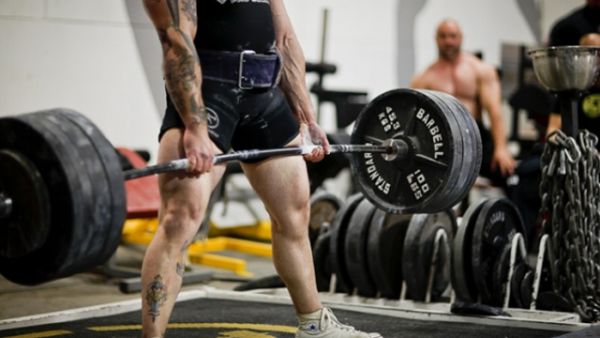In the ‘70s, top powerlifters like John Kuc, John Cole, and Don Reinhoudt had outstanding deadlifts, with personal bests around 900 pounds. The deadlift was considered the king of compound exercises.
These days, many powerlifters choose to compete only in the bench press, and for those that compete in all three (bench press, squat, and deadlift), the deadlift takes the back seat because of assistance gear that can add hundreds of pounds to their bench and squat, but nothing to their deadlift.
Well, the fact is the deadlift is, hands down, one of toughest—and most rewarding—exercises you can do. It’s the ultimate full-body workout, training just about every muscle group in the body: leg muscles, glutes, the entire back, core, and arm muscles. Anything that’s involved in producing whole-body power is blasted by the deadlift, and it’s an integral part of any serious strength training program.
Oddly enough, it’s also one of the most neglected compound exercises by both guys and gals; the unfortunate victim of the long-standing myth that it’s “bad for your back.”
At first, it would seem to make sense that lifting hundreds of pounds off the ground—putting all that pressure on your back, particularly your low-back and erector spinae muscles (also known as the spinal erectors)—would be a recipe for spinal disaster.
Anecdotal evidence is ambivalent: we all know or have heard of someone that “messed up their back deadlifting,” yet also know that many serious strength trainers, bodybuilders, and powerlifters swear by it.
So, is the deadlift bad for your back when performed properly?
Let’s turn to a series of scientific studies to learn more about this oft-feared, oft-revered lift.
- The Science of Deadlifting
- Two Useful Variations of the Deadlift: Sumo and Hex
- So, do you deadlift? What’s your favorite style? Have anything else to add? Let me know in the comments below!
Table of Contents
The Science of Deadlifting

Let’s start with a study conducted by the University of Valencia to determine the most effective way to train the paraspinal muscles, which run down both sides of your spine and play a major role in the prevention of back injuries.
Researchers had 25 people with no low-back pain perform two types of exercise for their backs: body weight exercises like lumbar extensions, forward flexions, single-leg deadlifts, and bridges; and two weighted exercises, deadlifts and lunges, using 70% of their one-rep max weight. Muscle activity was measured using electromyography, a technique of evaluating and recording electrical activity produced by muscles (the more and harder a muscle contracts, the more electrical activity takes place inside it).
The result: deadlifts most activated the paraspinal muscles. And it wasn’t even close. The deadlift’s average electromyographic muscle activity was 88% and peaked at 113%, whereas the back extension produced an average activity of 58% and peak of 55%, and the lunge an average of 46% and peak of 61%. The rest of the exercises’ average activities rang in between 29-42% (the supine bridge on a BOSU ball was the least effective, in case you were wondering).
Thus, researchers concluded, the deadlift is an incredibly effective way to strengthen the paraspinal muscles.
Another study conducted by the University of Waterloo set out to determine how much low-back flexion deadlifting caused, and thus how much strain it put on the vertebrae and lumbar ligament (as there were many claims that the lift put these things under tremendous strain, which could lead to injury).
Researchers used real-time x-ray imaging (called fluoroscopy) to watch the spines of elite powerlifters while they fully flexed their spines with no weights, and while they deadlifted over 400 pounds. With the exception of one trial of one subject, all men completed their deadlifts within the normal range of motion they displayed during full flexion. Ligament lengths were unaffected, indicating that they don’t help support the load, but instead limit range of motion.
So, as we can see, a proper deadlift effectively strengthens your entire back, including your erector spinae muscles, and doesn’t force anything unnatural in terms of range of motion. And in case you’re wondering, the major “no-no” in deadlifting is rounding your back, as this shifts much of the stress away from the erector spinae muscles to the vertebrae and ligaments…and this is what’s bad for your back.


Two Useful Variations of the Deadlift:
Sumo and Hex

While you can’t go wrong doing a full-range conventional deadlift, there are two useful variations that you should know about.
The sumo deadlift uses a wide stance (1.5-2 times the width of your shoulders) to shorten the range of motion and shearing force on the lower back. It also can feel more comfortable in the hips than a conventional deadlift, depending on your biomechanics (if you walk with your toes pointed out, the sumo may be better for you).
The downside of the sumo deadlift is the reduced range of motion, which results in less work done, which means less muscle development. Nevertheless, give this variation a try if you lack the flexibility to do a conventional deadlift, if it just feels very uncomfortable (certain people’s bodies are better suited to the sumo deadlift), or if it’s causing low-back pain.
The hex bar—or trap bar—deadlift is a great way to learn to deadlift, because it doesn’t require as much hip and ankle mobility to get to the bar, and it puts less shearing stress on the spine. It also allows you to lift more weight than the conventional deadlift, which may make it a more effective exercise for developing overall lower body power. That said, the conventional deadlift is more effective in strengthening the erector spinae muscles and hip muscles, because the hex-bar deadlift is more like a squat due to the increased load it places on the quadriceps.
So there you have it: deadlifting isn’t “bad for your back,” and to the contrary, is actually a great way to protect yourself against back injury and low-back pain. I think it should be included in all workout routines, and feel free to try all three variations to see which you like best.
And while someone who already has low-back pain or a disc injury will need to do a rehabilitation program of some kind before they can perform conventional deadlifts, this will often include sumo and/or hex deadlifts to gradually strengthen the erector spinae muscles and restore structural balance.
Oh and before I sign off, a caveat and comment:
Some people advocate deadlifting on unstable surfaces like the BOSU ball. Don’t bother with this—it decreases the effectiveness of the exercise.
Some people don’t deadlift because they believe regular squatting makes it unnecessary. They’re wrong. Research has shown that these two lifts train very different sets of muscles.
So, do you deadlift? What’s your favorite style? Have anything else to add? Let me know in the comments below!
+ Scientific References
- Hales ME, Johnson BF, Johnson JT. Kinematic analysis of the powerlifting style squat and the conventional deadlift during competition: is there a cross-over effect between lifts? J strength Cond Res. 2009;23(9):2574-2580. doi:10.1519/JSC.0b013e3181bc1d2a
- Chulvi-Medrano I, García-Massó X, Colado JC, Pablos C, de Moraes JA, Fuster MA. Deadlift muscle force and activation under stable and unstable conditions. J strength Cond Res. 2010;24(10):2723-2730. doi:10.1519/JSC.0b013e3181f0a8b9
- Swinton PA, Stewart A, Agouris I, Keogh JWL, Lloyd R. A biomechanical analysis of straight and hexagonal barbell deadlifts using submaximal loads. J strength Cond Res. 2011;25(7):2000-2009. doi:10.1519/JSC.0b013e3181e73f87
- Escamilla RF, Francisco AC, Fleisig GS, et al. A three-dimensional biomechanical analysis of sumo and conventional style deadlifts. Med Sci Sports Exerc. 2000;32(7):1265-1275. doi:10.1097/00005768-200007000-00013
- Escamilla RF, Lowry TM, Osbahr DC, Speer KP. Biomechanical analysis of the deadlift during the 1999 Special Olympics World Games. Med Sci Sports Exerc. 2001;33(8):1345-1353. doi:10.1097/00005768-200108000-00016
- Cholewicki J, McGill SM. Lumbar posterior ligament involvement during extremely heavy lifts estimated from fluoroscopic measurements. J Biomech. 1992;25(1):17-28. doi:10.1016/0021-9290(92)90242-s
- Colado JC, Pablos C, Chulvi-Medrano I, Garcia-Masso X, Flandez J, Behm DG. The progression of paraspinal muscle recruitment intensity in localized and global strength training exercises is not based on instability alone. Arch Phys Med Rehabil. 2011;92(11):1875-1883. doi:10.1016/j.apmr.2011.05.015









